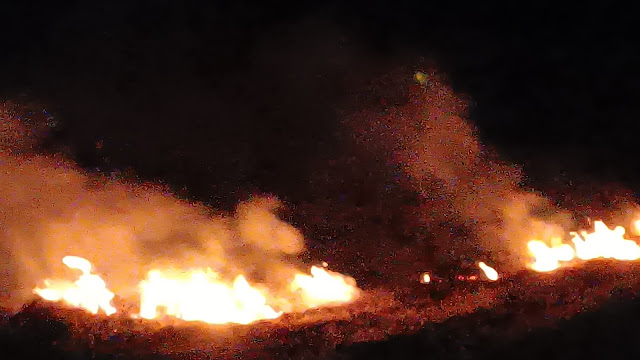Through a Conservation Reserve Program several years ago, I chose to plant the shorter Blue Grama Native grass variety, because I thought the taller variety would be more difficult to manage in a controlled burn, when in reality either variety has the potential to be troublesome in the right conditions. As I told a friend this morning, when he talked about never burning his tall Native grass or anything ever again, "It's much safer when you're prepared for the contingencies and just do a little at a time."
 |
| Same field a week ago when the temperatures were much colder, at about 15 degrees. |
 |
| Fire slowly burning against the wind, generally provides a good cleansing burn down to the ground provided the ground isn't too cold. |
Many years ago before I knew much about wildfire danger; I started a fire after dark along a little field not far from the creek, when the fire got away from me. I had only a bucket, a couple pair of old water-soaked blue jeans as fire swatters, a shovel, and a rake. As it was, during that time, there were no cellphones, so I had to run 150 yards to the house and call a nearby neighbor for help; his wife called others — and those who could, showed up. One guy drove his tractor into the yard from a nearby field when he saw the glow in the sky and all the cars driving into our road.
Some of us formed a bucket brigade from the creek. I stood in the creek filling buckets with water and passing them back, as other people swatted the flames out or raked the soil black. It was during that fire I saw fire burn across the surface of the water, where grass had grown up through it, that I thought for sure would stop it. Gaining traction in our fire fight, we stopped the fire on its opposite side just before it ascended the creek bank and spread westward into the field of newly planted trees. I later learned that people could see the glow of the fire from the Nine Mile Corner, five miles north of Wannaska. After the others went home, I stayed with the fire all night putting out smoldering pockets in fallen and standing trees, cutting them down as necessary.
Last week one evening the weather was just about perfect, fire-wise, having just enough SE wind to keep the fire moving. Humidity was in the 40% range, and the temperature very cool at around 15-20 degrees. The Native grass had been free of snow for a couple weeks and looked dry enough to easily ignite being the very threat that prompted me to act on it in the first place. Spring fires always carry a higher potential of explosiveness, with all the tinder-dry vegetation around. The only thing being that, if the grasses are rooted in ice, only the material above the ice burns; and when the ice melts, there's still a layer of tinder dry debris present. This little field was half totally dry on its west end and its mowed east-half partially under water; the high grass was my target anyway.
The only problem staring me in the face was keeping the 5-gallon water-filled backpacks and their brass hand-operated piston pumps from freezing up. I used windshield washer antifreeze (should've used 50/50 automotive antifreeze instead) mixed with water in the bags, but I discovered neither of my pumps worked despite being stored in the house during the winter. I thought they'd be ready to go, but I should know that there's always issues with dry seals and stuff like that. It took some head scratching to recall the issues, but I finally got them both to work. I could've been out there around 5 pm but by then it was completely dark with only the areas on fire and my headlamp providing the light. My daughter called from Iowa after learning what I was doing, again; we talked for over two hours. Then my wife called to see if I was still alive, when a truck that I didn't recognize came down our road slowly. I realized they were checking out if anyone was managing the fire.
Seeing me silhouetted against the flames, they stopped their vehicle and turned around. The driver probably saying to his passenger, "It's that time of year. .."
 |
| Palmville Township's 121-year old one-room school, District 44 West, nestled in Blue Grama Native Grass grown by using fire carefully. |




This east coaster feels edified. The picture at the end speaks volumes!
ReplyDeleteGreat visuals.
ReplyDeleteOur own scorched-earth policy has been watered down.
You are more courageous than I am! Thanks for the photos - almost like standing there with you. JPS
ReplyDeleteAll that wind talking you don't need water
ReplyDelete